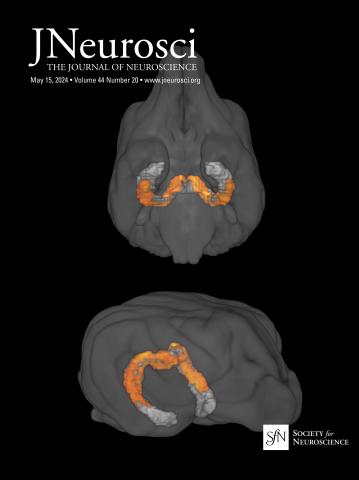Developmental spike timing-dependent long-term depression requires astrocyte D-serine at L2/3-L2/3 synapses of the mouse somatosensory cortex.
IF 4.4
2区 医学
Q1 NEUROSCIENCES
引用次数: 0
Abstract
Spike timing-dependent plasticity (STDP) is a learning rule important for synaptic refinement and for learning and memory during development. While different forms of presynaptic t-LTD have been deeply investigated, little is known about the mechanisms of somatosensory cortex postsynaptic t-LTD. In the present work, we investigated the requirements and mechanisms for induction of developmental spike timing-dependent long-term depression (t-LTD) at L2/3-L2/3 synapses in the juvenile mouse somatosensory cortex. We found that P13-21 mice of either sex show t-LTD at L2/3-L2/3 synapses induced by pairing single presynaptic activity with single postsynaptic action potentials at low stimulation frequency (0.2 Hz) is expressed postsynaptically, and requires the activation of ionotropic postsynaptic NMDA-type glutamate receptors containing GluN2B subunits. In addition, it requires postsynaptic Ca2+, Ca2+ release from internal stores, calcineurin, postsynaptic endocannabinoid (eCB) synthesis, activation of CB1 receptors and astrocytic signalling to release the gliotransmitter d-serine to activate postsynaptic NMDARs to induce t-LTD. These results show direct evidence of the mechanism involved in developmental postsynaptic t-LTD at L2/3-L2/3 synapses, revealing a central role of astrocytes and their release of D-serine in its induction.Significance statement We show here the mechanisms and role of astrocytes and gliotransmitters in a postsynaptic spike timing dependent long-term depression (t-LTD) form defined at layer (L)2/3-L2/3 synapses of the somatosensory cortex. We have discovered that this form of plasticity involves N-methyl D-aspartate receptors (NMDAR) containing the GluN2B subunit and requires astrocytes and the gliotransmitter D-serine to co-activate (together with glutamate) postsynaptic NMDAR to mediate LTD. This can be a general mechanism in the brain to define different forms of plasticity. Defining the mechanisms of synaptic plasticity may have important implications for brain repair, sensorial recovery, the treatment of neurodevelopmental disorders and even, for educational policy.小鼠躯体感觉皮层L2/3-L2/3突触的发育尖峰计时依赖性长期抑制需要星形胶质细胞D-丝氨酸。
尖峰定时可塑性(STDP)是一种学习规则,对突触的完善以及发育过程中的学习和记忆非常重要。尽管人们对不同形式的突触前t-LTD进行了深入研究,但对躯体感觉皮层突触后t-LTD的机制却知之甚少。在本研究中,我们研究了诱导幼年小鼠体感皮层 L2/3-L2/3 突触发育尖峰计时依赖性长期抑制(t-LTD)的要求和机制。我们发现,在低刺激频率(0.2 Hz)下将单突触前活动与单突触后动作电位配对诱导 L2/3-L2/3 突触的 t-LTD 是在突触后表达的,并且需要激活含有 GluN2B 亚基的离子突触后 NMDA 型谷氨酸受体。此外,它还需要突触后 Ca2+、内部储存的 Ca2+释放、钙神经蛋白、突触后内源性大麻素(eCB)合成、CB1 受体激活和星形胶质细胞信号释放神经胶质递质 d-丝氨酸来激活突触后 NMDARs,从而诱导 t-LTD。这些结果直接证明了L2/3-L2/3突触后t-LTD的发育机制,揭示了星形胶质细胞及其释放的D-丝氨酸在诱导t-LTD中的核心作用。意义声明 我们在此展示了星形胶质细胞和胶质递质在突触后尖峰时序依赖性长期抑制(t-LTD)中的机制和作用。我们发现,这种可塑性形式涉及含有 GluN2B 亚基的 N 甲基 D-天冬氨酸受体(NMDAR),需要星形胶质细胞和胶质递质 D-丝氨酸共同激活(与谷氨酸一起)突触后 NMDAR,以介导 LTD。这可能是大脑中定义不同形式可塑性的通用机制。确定突触可塑性的机制可能对大脑修复、感官恢复、神经发育障碍的治疗甚至教育政策都有重要意义。
本文章由计算机程序翻译,如有差异,请以英文原文为准。
求助全文
约1分钟内获得全文
求助全文
来源期刊

Journal of Neuroscience
医学-神经科学
CiteScore
9.30
自引率
3.80%
发文量
1164
审稿时长
12 months
期刊介绍:
JNeurosci (ISSN 0270-6474) is an official journal of the Society for Neuroscience. It is published weekly by the Society, fifty weeks a year, one volume a year. JNeurosci publishes papers on a broad range of topics of general interest to those working on the nervous system. Authors now have an Open Choice option for their published articles
 求助内容:
求助内容: 应助结果提醒方式:
应助结果提醒方式:


